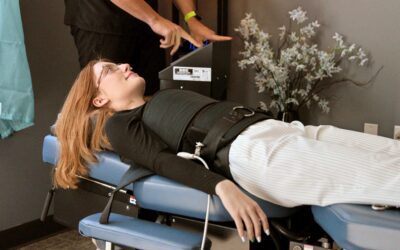While a seatbelt and air bags help prevent your body from crashing into the steering wheel and windshield in a car accident, they don’t prevent your head from snapping forward or backward.
If your car suddenly stops (or suddenly moves if you’re hit from behind) while your body may be restrained, the swift, jolting movements of your head can lead to a range of physical injuries, with whiplash being the most common.
Characterized by neck pain that results from a sudden back-and-forth movement of the neck, whiplash is more than just a temporary discomfort. It can significantly impact your quality of life if left untreated. Whiplash can damage muscles, tendons, ligaments, nerves, and even bones.
Chiropractic care offers a proven, effective method for treating whiplash, ensuring that those affected can return to their daily activities with minimal disruption. Consistent chiropractic treatment is key to avoid lingering pain.
Common Symptoms of Whiplash
Whiplash injuries can manifest in several ways, including neck pain and stiffness, headaches at the base of the skull, dizziness, blurred vision, and fatigue. These symptoms can appear immediately following an accident or may develop days after the incident, making it crucial to seek professional assessment and care promptly.
You may walk away from a car accident feeling okay initially, only to suffer from neck aches and stiffness within a day or two. You may also have symptoms that radiate elsewhere in your body, causing shoulder tightness or headaches.
It can be hard to turn your head. Some people become nauseous and woozy. You may find you are more irritable or tired, and it’s possible to feel depressed, too. You could suffer from numbness or tingling in your arms or hands.
In some cases, individuals might also experience difficulty concentrating, memory problems, ringing in the ears, sleep disturbances, and irritability.
How Bad Is It?
Whiplash symptoms depend on the grade of injury and commonly include the following:
Grade 1: Neck pain includes stiffness, soreness, or tenderness, but no physical sign of injury on the neck.
Grade 2: Symptoms from grade 1 and musculoskeletal signs like tenderness or restricted range of motion. You may have radiating pain, spasms, or stiffness.
Grade 3: Symptoms from grades 1 and 2 and neurological issues like pins and needles, inability to feel hot or cold, vision problems, dizziness, weakness, hoarseness, and headaches.
Grade 4: Neck complaints from grades 1-3 and fracture or dislocation.
Concussions and Whiplash
Be aware that whiplash and concussions often occur simultaneously due to sudden impact or jostling. Seek medical attention immediately if you are involved in a car accident. You may need time to rest and take time off from work to allow your body and brain to heal. Do not rush back or you will risk prolonging your recovery time.
Diagnosing Whiplash
Your doctor will ask you to perform simple movements to test your range of motion and pinpoint pain. X-rays, MRIs, and CT scans can’t always indicate whiplash, but your doctor might order them to eliminate other sources of pain.
Treating Whiplash
Chiropractic care can help alleviate pain. However, sometimes your body needs time to reduce inflammation and nerve irritation before chiropractic adjustments. In cases where an injury is too severe or if there are other complicating health issues, a chiropractor may refer the patient to another healthcare provider for additional treatment.
Whiplash is typically treated by applying icepacks for the first week or so, then heating pads.
You will want to move your neck gently as soon as you can so that your muscles don’t tighten up. Remember, motion is lotion.
Some people benefit from painkillers and anti-inflammatory medication and in serious cases you may be prescribed a muscle relaxant.
For most patients, it’s important to seek chiropractic treatment as soon as you can after a car accident so that your spine can return to proper alignment and allow you to heal. Communicate with your chiropractor immediately following a car accident to figure out a treatment plan.
Chiropractors specialize in the treatment of musculoskeletal issues, making them well-equipped to address the complexities of whiplash. Through a comprehensive evaluation, which may include X-rays or MRI scans, your chiropractor can assess the extent of your injury and develop a tailored treatment plan designed to alleviate pain, restore range of motion, and promote healing.
The cornerstone of chiropractic care for whiplash are chiropractic adjustments. This involves the application of controlled force to a joint, moving it back to its normal range of motion.
This can help alleviate pain, reduce inflammation, and improve function. Alongside adjustments, chiropractors may employ other therapeutic methods such as mobilization, which gently moves the joint through its range of motion, and muscle relaxation or stimulation techniques, which can help relieve muscle tension.
Electronic muscle stimulation can stimulate the nerves for healing.
You may also try massage therapy or cupping treatments to increase blood flow to the injury.
In addition to these hands-on treatments, chiropractors often incorporate rehabilitative exercises into the care plan. These exercises are designed to strengthen the muscles around the spine, improve posture, and increase flexibility, further supporting the healing process.
You may need physical therapy to increase your range of motion. Do your homework and your body will love you.
Education is another crucial aspect of chiropractic care. Chiropractors provide patients with advice on ergonomics, lifestyle changes, and exercises that can be done at home to enhance recovery and reduce the likelihood of re-injury.
This holistic approach ensures that patients are not only treated for their current symptoms but are also equipped with the knowledge and tools needed to maintain their health and wellbeing long-term.
By addressing both the immediate symptoms and underlying causes of whiplash, chiropractic care can not only expedite recovery but also help prevent future injuries.
Car wrecks can be incredibly stressful, especially if they cause injuries such as whiplash. If you don’t feel right, seek treatment and get back to healthy living.
We’re Here To Help
If you’re experiencing symptoms of whiplash following a car crash, seeking the expertise of a chiropractor can be a crucial step towards recovery.
Through a combination of hands-on treatments, rehabilitative exercises, and personalized care plans, chiropractic care offers a safe, effective way to address whiplash, helping patients return to their normal lives free from pain and discomfort.
The sooner you seek treatment, the better your chances of a swift and complete recovery.
Call 417 Spine to schedule an appointment and get started on the road to better health that comes naturally.


